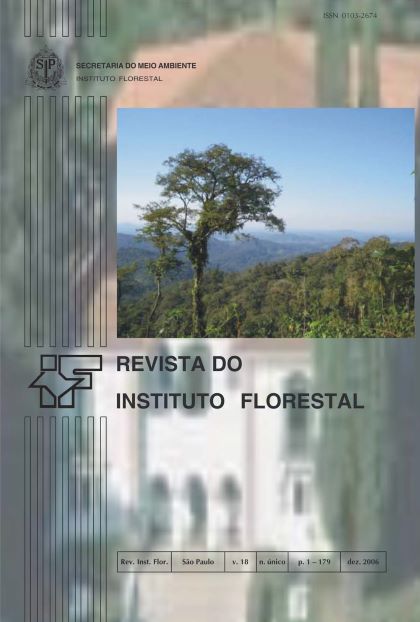ESTUDO DA CONTAMINAÇÃO BIOLÓGICA POR Pinus spp. EM TRÊS DIFERENTES ÁREAS NA ESTAÇÃO ECOLÓGICA DE ITIRAPINA (SP, BRASIL)
DOI:
https://doi.org/10.24278/2178-5031.200618319Palavras-chave:
contaminação biológica, invasão de Pinus, cerrado, manejoResumo
Constituída por cerrado em suas diversas expressões fisionômicas, a Estação Ecológica de Itirapina sofre com a disseminação de espécies de Pinus provenientes da Estação Experimental de Itirapina, com a qual faz divisa. Este trabalho teve como objetivo analisar o processo de invasão biológica dessas espécies de Pinus na área da Estação Ecológica, procurando avaliar os seguintes fatores: qual espécie é a mais invasiva na área, quais são os possíveis sítios de disseminação e quais são as áreas mais atingidas pela invasão. Tal avaliação procura dar subsídios para uma estratégia de manejo da área, visando minimizar o processo de contaminação da vegetação nativa por Pinus spp. Verificou-se que a espécie Pinus elliottii é a mais invasiva na área, sendo os talhões da Estação Experimental os principais sítios de disseminação desta espécie. As áreas úmidas da Estação Ecológica são as mais afetadas, havendo nestes locais uma alta densidade de indivíduos de Pinus elliottii. Os resultados sugerem a necessidade de se instalar uma barreira biológica, principalmente nos talhões da Estação Experimental contíguos à Estação Ecológica, visando minimizar a dispersão de sementes destes talhões, além de procurar alternativas de remoção dos indivíduos que já se instalaram nessa Unidade de Conservação do grupo de proteção integral.
Downloads
Referências
DELGADO, J. M. et al. Plano de Manejo Integrado das Unidades de Itirapina – SP. IF Sér. Reg., São Paulo, n. 27, p. 1-153, 2004.
GROTKOPP, E.; REJMÁNEK, M.; ROST, T. L. Toward a causal explanation of plant invasiveness: seedling growth and life-history strategies of 29 pine (pinus) species. The American Naturalist, Chicago, v. 159, n. 4, p. 398-419, 2002.
GUIMARÃES, T. Espécie invasora ataca áreas protegidas. Folha de São Paulo, São Paulo, 16 maio 2005, Folha Ciência, página A13.
HUGHES, C. E.; STYLES, B. T. The benefits and risks of woody legume introductions. Monogr. Syst. Bot. Missouri Bot. Gard., St. Louis, v. 29, 1989, p. 505-531. UNIÃO INTERNACIONAL PARA A CONSERVAÇÃO DA NATUREZA - IUCN. Guidelines for protected areas management categories. Gland, 1994. 29 p.
KAGEYAMA, P. Y.; PINÃ-RODRIGUES, F. C. M. Fatores que afetam a produção de sementes. In: AGUIAR, I. B. de; PINÃ-RODRIGUES, F. C. M.; FIGLIOLIA, M. B. Sementes florestais tropicais. Brasília, DF: ABRATES, 1993. cap. 1, p. 19-46.
KRONKA, F. J. N.; BERTOLANI, F.; PONCE, R. H. A cultura do pinus no Brasil. São Paulo: Sociedade Brasileira de Silvicultura, 2005. 156 p.
KRONKA, F. J. N. et al. Áreas de domínio do Cerrado no Estado de São Paulo. São Paulo: Secretaria do Meio Ambiente, 1998. 84 p.
LEDGARD, N. J.; LANGER, E. R. Wilding prevention – guidelines for minimizing the risk of unwanted wilding spread from new plantings of introduced conifers. New Zealand: Forest Research, 1999. 20 p.
LIESENFELD, M. V. A.; PELLEGRIM, L. M. Risco biológico: a invasão por Pinus e a problemática das espécies alienígenas vegetais no Parque Estadual de Itapuã - Viamão, RS. Pelotas: Instituto Gaúcho de Estudos Ambientais, 2004. 9 p. LIMA, L. Espécies invasoras. Rev. Galileu, São Paulo, n. 145, p. 45-56, 2003.
LORENZI, H. et al. Árvores exóticas no Brasil: madeireiras, ornamentais e aromáticas. Nova Odessa: Instituto Plantarum, 2003. 368 p.
RICHARDSON, D. M. Forestry trees as invasive aliens. Conservation Biology, Cambridge, v. 12, n. 1, p. 18-26, 1998. VIEIRA, S. Estatística experimental. 2. ed. São Paulo: Atlas, 1999. 184 p.
ZANCHETTA, D. et al. 1ª revisão do Plano de Manejo das Unidades de Itirapina – projeto em execução. São Paulo: Secretaria do Meio Ambiente, Instituto Florestal, 2006. Não publicado.
ZILLER, S. R. Plantas exóticas invasoras: a ameaça da contaminação biológica. Rev. Ciência Hoje, São Paulo, v. 20, n. 178, p. 77-79, 2001.
ZILLER, S. R.; GALVÃO, F. A degradação da estepe gramíneo-lenhosa no Paraná por contaminação biológica de Pinus elliottii e Pinus taeda. Floresta, Curitiba, v. 32, n. 1, p. 42-47, 2001















